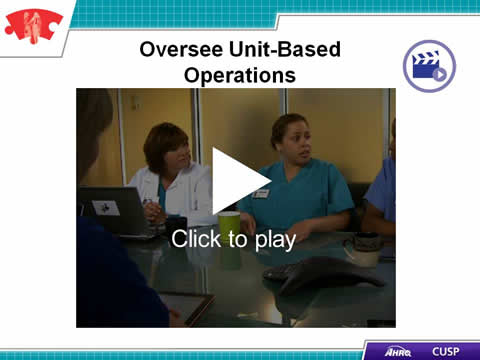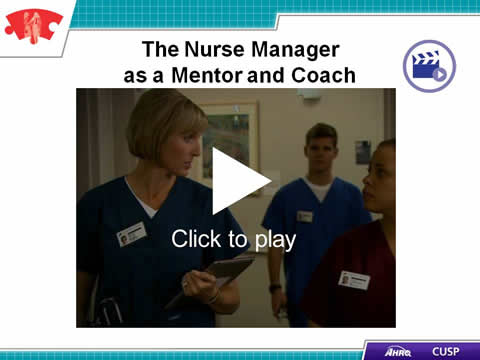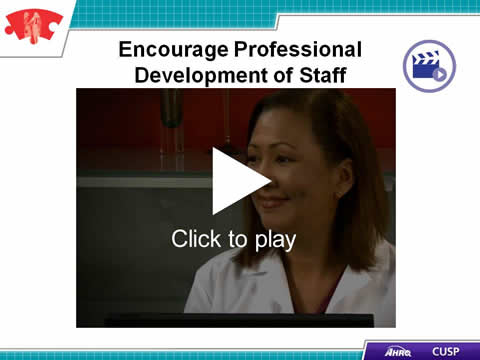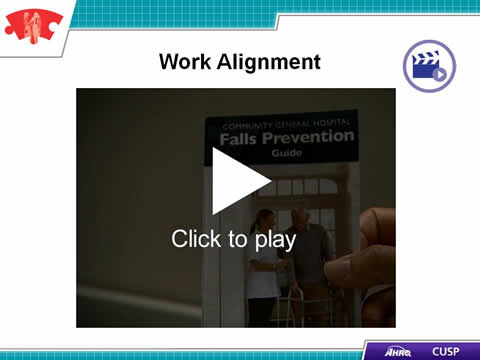CUSP Toolkit: The Role of the Nurse Manager
CUSP Toolkit
Contents
Slide 1. Cover Slide.
Slide 2. Learning Objectives
Slide 3. What is a Nurse Manager?
Slide 4. Why Are Nurse Managers So Important?1, 2, 3, 4
Slide 5. The Nurse Manager's Dual Roles
Slide 6. Oversee Unit-Based Operations
Slide 7. The Leadership and Management Roles of the Nurse Manager
Slide 8. The Nurse Manager as a Mentor and Coach
Slide 9. Responsibilities of the Nurse Manager
Slide 10. Human Resource Management4
Slide 11. Encourage Professional Development of Staff
Slide 12. Customer Focus
Slide 13. Financial Responsibility
Slide 14. Standards of Care
Slide 15. Alignment with Organizational Goals5
Slide 16. Frameworks that are Useful for Nurse Managers
Slide 17. The Baldridge Health Care Criteria for Performance Excellence Framework6
Slide 18. Quint Studer's Five Pillars7
Slide 19. Balanced Scorecard8
Slide 20. The American Organization of Nurse Executives Nurse Manager Leadership Partnership Learning Domain Framework9
Slide 21. Measurement Tactics: Customer/Patient Focus
Slide 22. Work Alignment
Slide 23. Quality/Safety
Slide 24. Financial
Slide 25. Summary
Slide 26. CUSP Tools
Slide 27. TeamSTEPPS® Tools
Slide 28. References
Slide 29. References
Slide 30. References
Note: Slide content is presented below each of the images.
Slide 1. Cover Slide.
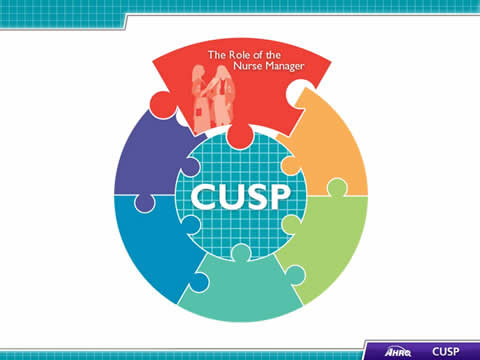
Image: CUSP logo.
Slide 2. Learning Objectives
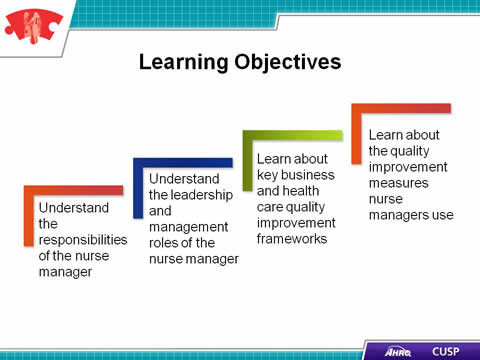
- Understand the responsibilities of the nurse manager.
- Understand the leadership and management roles of the nurse manager.
- Learn about key business and health care improvement frameworks.
- Learn about the quality improvement measures that nurse managers use.
Slide 3. What is a Nurse Manager?
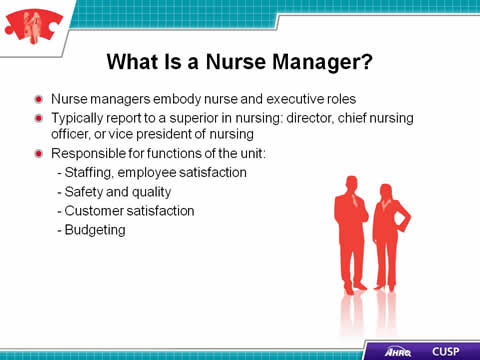
- Nurse managers embody a nurse and executive roles.
- Typically report to a superior in nursing: director, chief nursing officer, or vice president of nursing.
- Responsible for functions of the unit:
- Staffing, employee satisfaction.
- Safety and quality.
- Customer satisfaction.
- Budgeting.
Slide 4. Why Are Nurse Managers So Important?1,2,3,4
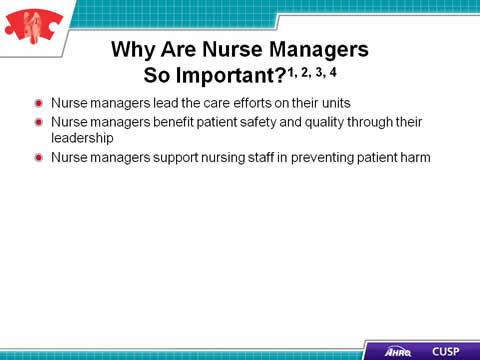
- Nurse managers lead the care efforts on their units.
- Nurse managers benefit patient safety and quality through their leadership.
- Nurse managers support nursing staff in preventing patient harm.
Slide 5. The Nurse Manager's Dual Roles
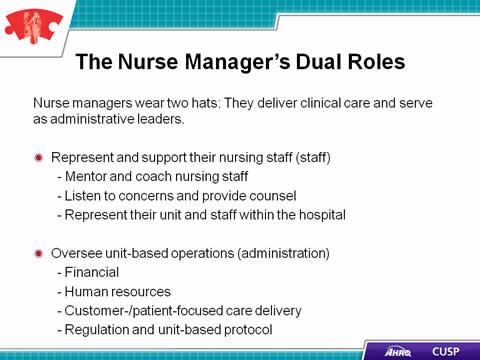
- Nurse managers wear two hats: They deliver clinical care and serve as administrative leaders.
- Represent and support their staff (staff):
- Mentor and coach nursing staff.
- Listen to concerns and provide counsel.
- Represent their unit and staff within the hospital.
- Oversee unit-based operations (administration):
- Financial.
- Human Resources.
- Customer-/patient-focused care delivery.
- Regulation and unit-based protocol.
Slide 6. Oversee Unit-Based Operations
Video icon
Click to play
Slide 7. The Leadership and Management Roles of the Nurse Manager
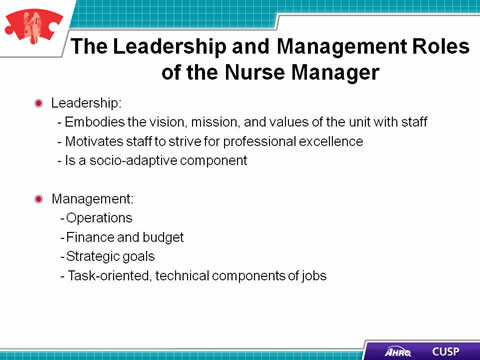
- Leadership:
- Embodies the vision, mission, and values of the unit with staff.
- Motivates staff to strive for professional excellence.
- Is a socio-adaptive component.
- Management:
- Operations.
- Finance and budget.
- Strategic goals.
- Task-orientated, technical components of jobs.
Slide 8. The Nurse Manager as a Mentor and Coach
Video icon
Click to play
Slide 9. Responsibilities of the Nurse Manager
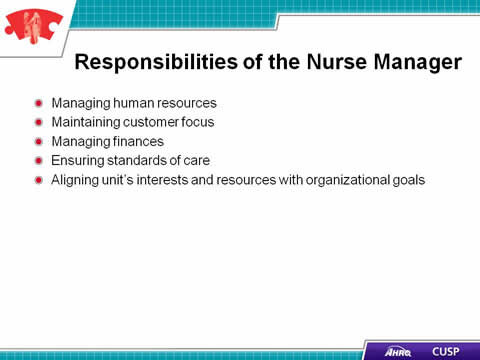
- Managing human resources.
- Maintaining customer focus.
- Managing finances.
- Ensuring standard of care.
- Aligning unit's interests and resources with organizational goals.
Slide 10. Human Resource Management4
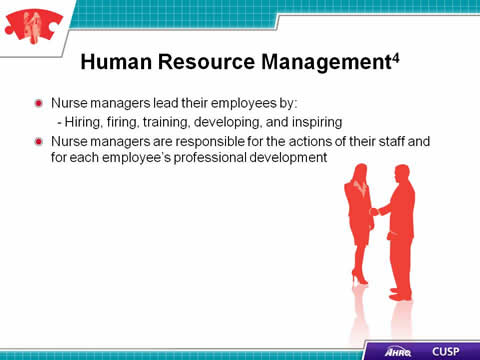
- Nurse managers lead their employees by:
- Hiring, firing, training, developing, and inspiring.
- Nurse managers are responsible for the actions of their staff and for each employee's professional development.
Slide 11. Encourage Professional Development of Staff
Video icon
Click to play
Slide 12. Customer Focus
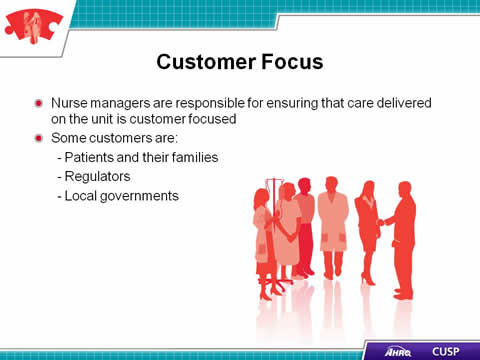
- Nurse managers are responsible for ensuring that care delivered on the unit is customer focused.
- Some customers are:
- Patients and their families.
- Regulators.
- Local governments.
Slide 13. Financial Responsibility
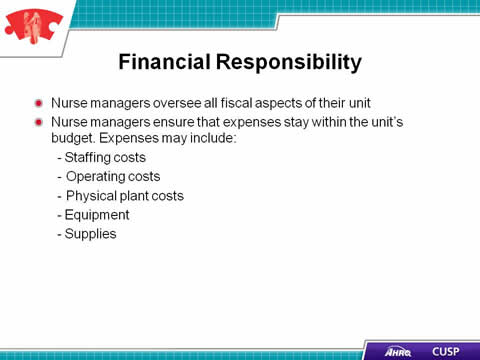
- Nurse managers oversee all fiscal aspects of their unit.
- Nurse managers ensure that expenses stay within the unit's budget. Expenses may include:
- Staffing costs.
- Operating costs.
- Physical plant costs.
- Equipment.
- Supplies.
Slide 14. Standards of Care
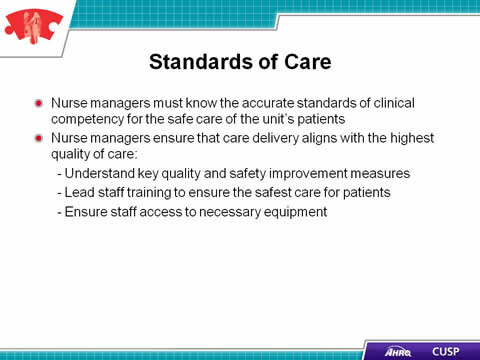
- Nurse managers must know the accurate standards of clinical competency for the safe care of the unit's patients.
- Nurse managers ensure that care delivery aligns with the highest quality of care:
- Understand key quality and safety improvement measures.
- Lead staff training to ensure the safest care for patients.
- Ensure staff access to necessary equipment.
Slide 15. Alignment with Organizational Goals5
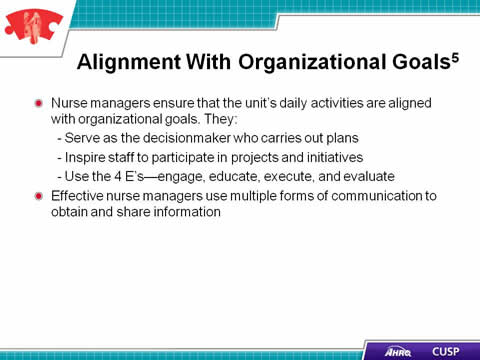
- Nurse managers ensure that the unit's daily activities are aligned with organizational goals. They:
- Serve as the decisionmaker who carries out plans.
- Inspire staff to participate in projects and initiatives.
- Use the 4 E's—engage, educate, execute, and evaluate.
- Effective nurse managers use multiple forms of communication to obtain and share information.
Slide 16. Frameworks that are Useful for Nurse Managers
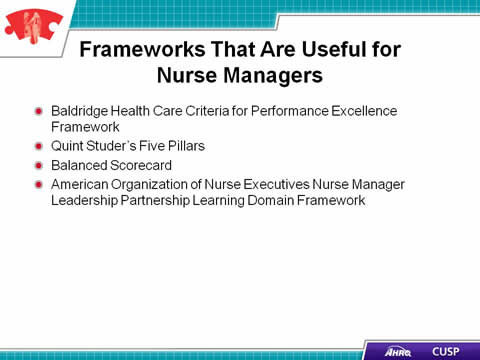
- Baldridge Health Care Criteria for Performance Excellence Framework.
- Quint Studer's Five Pillars.
- Balanced Scorecard.
- American Organization of Nurse Executives Nurse Manager Leadership Partnership Learning Domain Framework.
Slide 17. The Baldridge Health Care Criteria for Performance Excellence Framework6
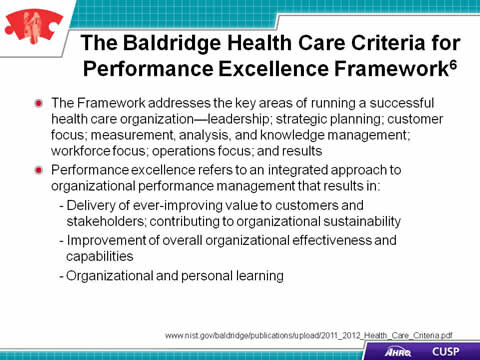
- The Framework addresses the key areas of running a successful health care organization-leadership; strategic planning; customer focus; measurement, analysis, and knowledge management; workforce focus; operations focus; and results.
- Performance excellence refers to an integrated approach to organizational performance management that results in:
- Delivery of ever-improving value to customers and stakeholders; contributing to organizational sustainability.
- Improvement of overall organizational effectiveness and capabilities.
- Organizational and personal learning.
http://www.nist.gov/baldridge/publications/upload/2011_2012_Health_Care_Criteria.pdf (Plugin Software Help)
Slide 18. Quint Studer's Five Pillars7
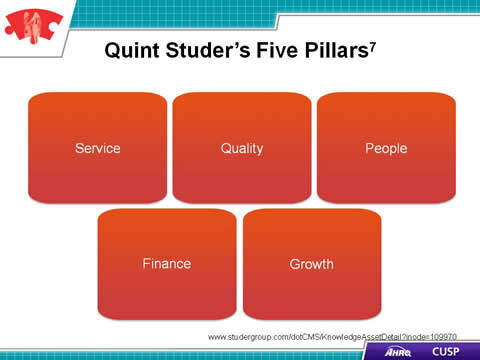
- Service.
- Quality.
- People.
- Finance.
- Growth.
http://www.studergroup.com/dotCMS/KnowledgeAssetDetail?inode=109970
Slide 19. Balanced Scorecard8
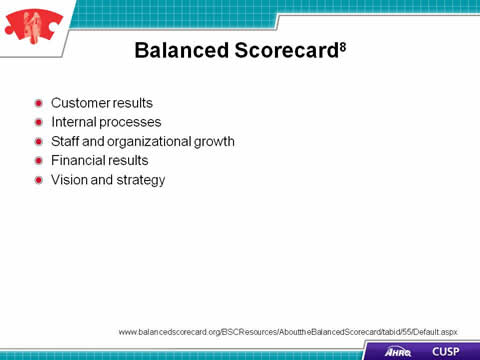
- Customer results.
- Internal processes.
- Staff and organizational growth.
- Financial results.
- Vision and strategy.
http://www.balancedscorecard.org/BSCResources/AbouttheBalancedScorecard/tabid/55/Default.aspx
Slide 20. The American Organization of Nurse Executives Nurse Manager Leadership Partnership Learning Domain Framework9
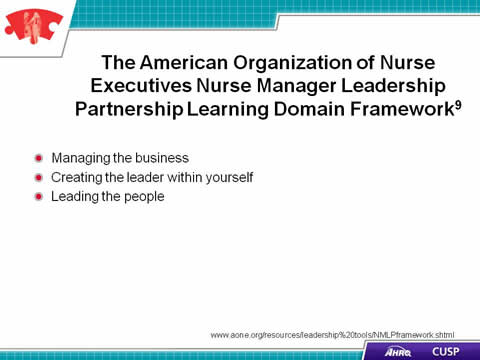
- Managing the business.
- Creating the leader within yourself.
- Leading the people.
http://www.aone.org/resources/leadership%20tools/NMLPframework.shtml
Slide 21. Measurement Tactics: Customer/Patient Focus
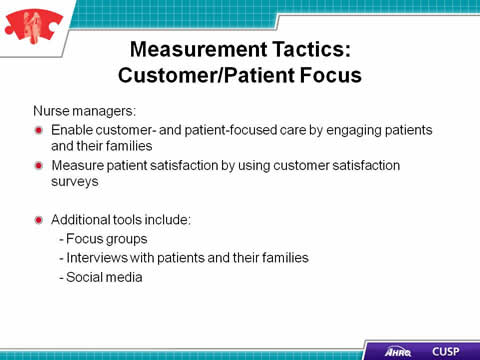
Nurse managers:
- Enable customer- and patient focused care by engaging the patient and their families.
- Measure patient satisfaction by using customer satisfaction surveys.
- Additional tools include:
- Focus groups.
- Interviews with patients and their families.
- Social media.
Slide 22. Work Alignment
Video icon
Click to play
Slide 23. Quality/Safety
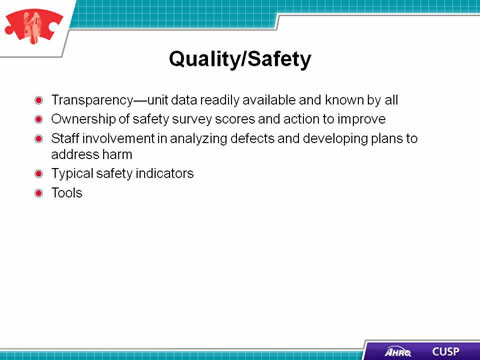
- Transparency—unit data readily available and known by all.
- Ownership of safety survey scores and action to improve.
- Staff involvement in analyzing defects and developing plan to address harm.
- Typical safety indicators.
- Tools.
Slide 24. Financial
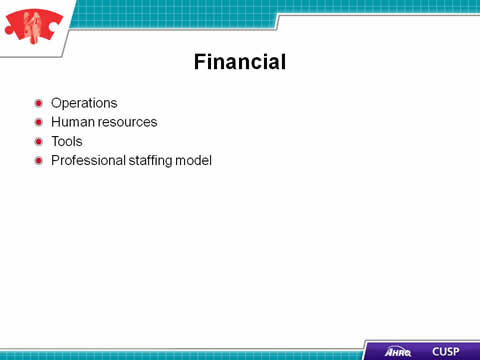
- Operations.
- Human resources.
- Tools.
- Professional staffing model.
Slide 25. Summary
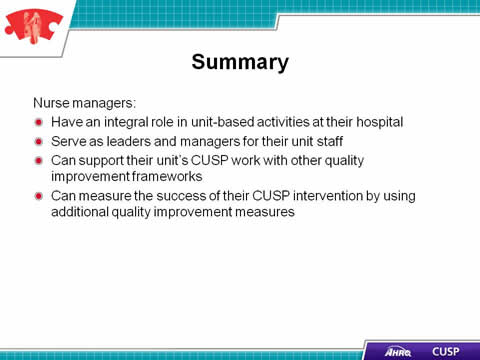
Nurse managers:
- Have an integral role in unit-based activities at their hospital.
- Serve as leaders and managers for their unit staff.
- Can support their unit's CUSP work with other quality improvement frameworks.
- Can measure the success of their CUSP intervention by using additional quality improvement measures.
Slide 26. CUSP Tools
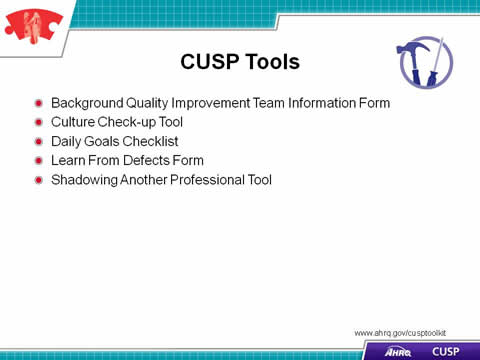
- Background Quality Improvement Team Information Form.
- Culture Check-up Tool.
- Daily Goals Checklist.
- Learn From Defects Form.
- Shadowing Another Professional Tool.
http://www.ahrq.gov/cusptoolkit
Slide 27. TeamSTEPPS® Tools
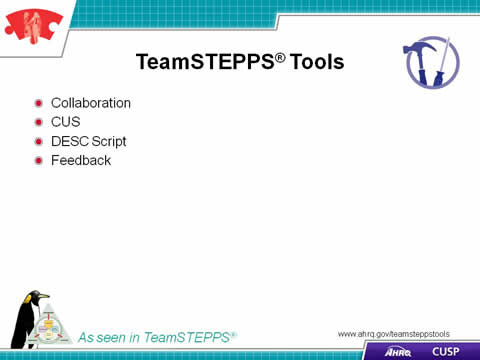
- Collaboration.
- CUS.
- DESC Script.
- Feedback.
Slide 28. References
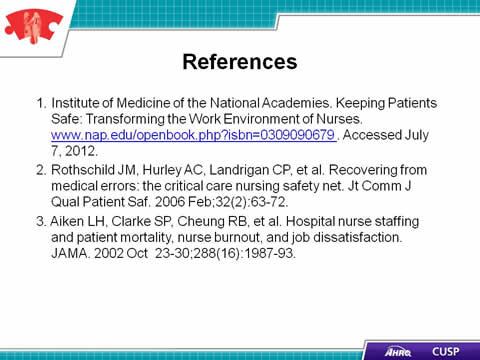
- Institute of Medicine of the National Academies. Keeping Patients Safe: Transforming the Work Environment of Nurses. http://www.nap.edu/openbook.php?isbn=0309090679. Accessed July 7, 2012.
- Rothschild JM, Hurley AC, Landrigan CP, et al. Recovering from medical errors: the critical care nursing safety net. Jt Comm J Qual Patient Saf 2006 Feb;32(2):63-72.
- Aiken LH, Clarke SP, Cheung RB, et al. Hospital nurse staffing and patient mortality, nurse burnout, and job dissatisfaction. JAMA 2002 Oct 23-30;288(16):1987-93.
Slide 29. References
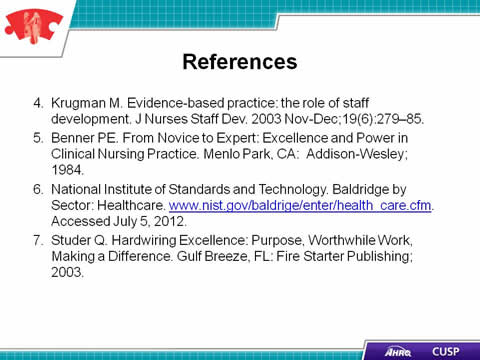
- Krugman M. Evidence-based practice: the role of staff development. J Nurses Staff Dev 2003 Nov-Dec;19(6):279-85.
- Benner PE. From Novice to Expert: Excellence and Power in Clinical Nursing Practice. Menlo Park, CA: Addison-Wesley; 1984.
- National Institute of Standards and Technology. Baldridge by Sector: Healthcare. http://www.nist.gov/baldrige/enter/health_care.cfm. Accessed July 5, 2012.
- Studer Q. Hardwiring Excellence: Purpose, Worthwhile Work, Making a Difference. Gulf Breeze, FL: Fire Starter Publishing; 2003.
Slide 30. References
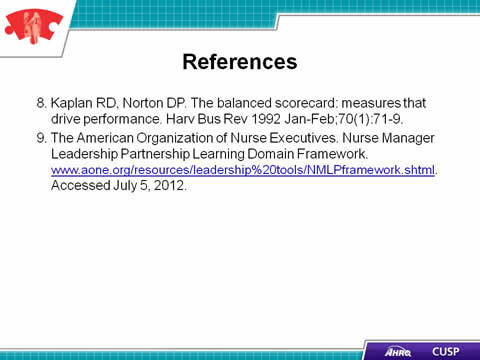
- Kaplan RD, Norton DP. The balanced scorecard: measures that drive performance. Harv Bus Rev 1992 Jan-Feb;70(1):71-9.
- The American Organization of Nurse Executives. Nurse Manager Leadership Partnership Learning Domain Framework. http://www.aone.org/resources/leadership%20tools/NMLPframework.shtml#.T_shshfY92A. Accessed July 5, 2012.




